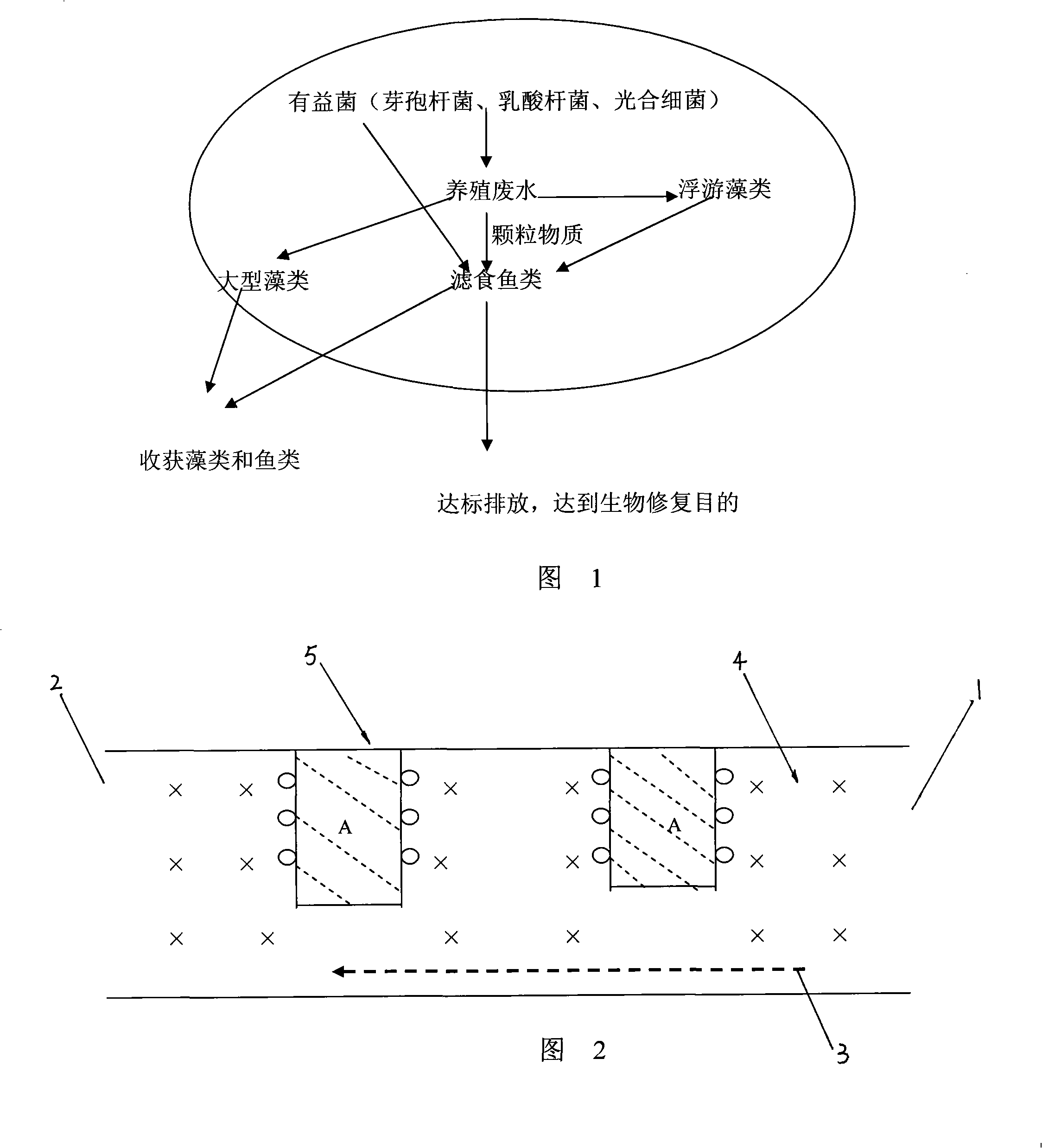Sea water culture environment multiple state position biological restoring method
A marine aquaculture and bioremediation technology, applied in the field of aquaculture environment restoration, can solve the problems of treating symptoms but not the root cause, high cost of human and material resources, complicated operations, etc., and achieves the effect of reducing pollution and achieving sustainable development.
- Summary
- Abstract
- Description
- Claims
- Application Information
AI Technical Summary
Problems solved by technology
Method used
Image
Examples
Embodiment 1
[0018] In Shanwei Honghai Bay Shrimp Farm, the aquaculture wastewater is discharged into the discharge ditch through the outlet, as shown in Figure 2. In the first stage, the shrimp pond water and the bottom wastewater of the shrimp pond are sampled to determine the various indicators of water quality and the content of beneficial bacteria , and then put Bacillus subtilis, Rhodopseudomonas palustris and Lactobacillus in a quantitative ratio of 3:1:1 according to the results of the determination to supplement beneficial bacteria such as Bacillus subtilis, Rhodopseudomonas palustris and Lactobacillus, to ensure that the spores The density of bacillus in the breeding wastewater is not small 3×10 4 CFU / ml, to remove nitrogen and phosphorus and transform organic matter. After 4 hours of treatment, water samples were taken to measure various indicators of water quality. Then stock no less than 100g of Nile tilapia in the ditches, and the amount of stocking is 0.5kg / m 3 . At the s...
Embodiment 2
[0023] In Haifeng Quanji Aquaculture Company in Shanwei City, the aquaculture wastewater from No. 1 pond was discharged into the discharge ditch through the outlet, as shown in Figure 2. In the first stage, the water in the shrimp pond and the wastewater at the bottom of the shrimp pond were first sampled to determine the water quality. subtilis, Rhodopseudomonas palustris and Lactobacillus in a quantitative ratio of 4:2:1 according to the results of the determination, to supplement Bacillus subtilis, Rhodopseudomonas palustris and lactic acid bacillus and other beneficial bacteria to ensure that the density of bacillus in the aquaculture wastewater is not small 3×10 4 CFU / ml, to remove nitrogen and phosphorus and transform organic matter. After 5 hours of treatment, water samples were taken to measure various indicators of water quality. Then stock no less than 100g bluefish in the ditches, and the stocking rate is 0.5kg / m 3 . At the same time, at least one 3m × 4m × 0.8m ...
Embodiment 3
[0028] In the Sanwei aquaculture farm in Chenghai District, Shantou City, the salinity specific gravity of the aquaculture water is 1.010, and the aquaculture wastewater is discharged into the discharge ditch through the outlet, as shown in Figure 2. In the first stage, the water in the shrimp pond and the wastewater at the bottom of the shrimp pond are treated first. Sampling was carried out to determine the various indicators of water quality and the content of beneficial bacteria, and then according to the results of the determination, Bacillus subtilis, Rhodopseudomonas palustris and Lactobacillus were added in a quantitative ratio of 6:3:1 to supplement Bacillus subtilis and Rhodopseudomonas palustris. Beneficial bacteria such as monascus and lactobacillus ensure that the density of bacillus in the aquaculture wastewater is not small 3×10 4 CFU / ml, to remove nitrogen and phosphorus and transform organic matter. After 4 hours of treatment, water samples were taken to measu...
PUM
 Login to View More
Login to View More Abstract
Description
Claims
Application Information
 Login to View More
Login to View More - R&D
- Intellectual Property
- Life Sciences
- Materials
- Tech Scout
- Unparalleled Data Quality
- Higher Quality Content
- 60% Fewer Hallucinations
Browse by: Latest US Patents, China's latest patents, Technical Efficacy Thesaurus, Application Domain, Technology Topic, Popular Technical Reports.
© 2025 PatSnap. All rights reserved.Legal|Privacy policy|Modern Slavery Act Transparency Statement|Sitemap|About US| Contact US: help@patsnap.com

